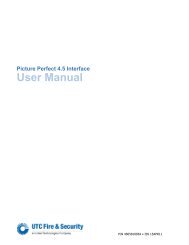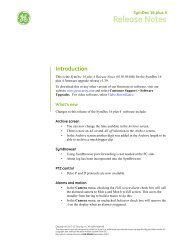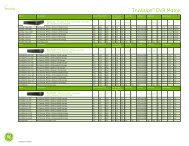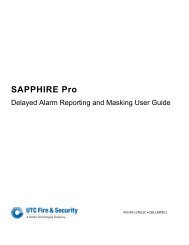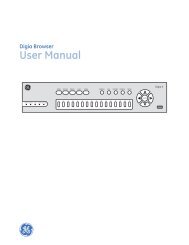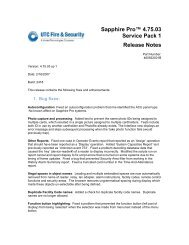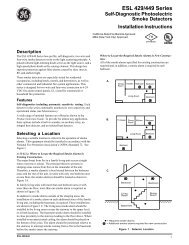CyberDome Programming Manual - UTCFS Global Security Products
CyberDome Programming Manual - UTCFS Global Security Products
CyberDome Programming Manual - UTCFS Global Security Products
You also want an ePaper? Increase the reach of your titles
YUMPU automatically turns print PDFs into web optimized ePapers that Google loves.
<strong>CyberDome</strong> Series
© 2003 Kalatel, a GE Interlogix company<br />
All Rights Reserved.<br />
Any GE Interlogix, Kalatel division, software supplied<br />
with GE Interlogix, Kalatel division, products is<br />
proprietary and furnished under license and can be used<br />
or copied only in accordance with the terms of such<br />
license.<br />
This document contains proprietary information that is<br />
protected by copyright. No part of this document may be<br />
reproduced or transmitted in any form or by any means<br />
without the prior written permission of GE Interlogix,<br />
Kalatel division.<br />
The information contained in this document is subject to<br />
change without notice. GE Interlogix, Kalatel division, in<br />
keeping pace with technological advances, is a company<br />
of product innovation. Therefore, it is difficult to ensure<br />
that all information provided is entirely accurate and upto-date.<br />
GE Interlogix, Kalatel division, accepts no<br />
responsibility for inaccuracies or omissions and<br />
specifically disclaims any liabilities, losses, or risks,<br />
personal or otherwise, incurred as a consequence,<br />
directly or indirectly, of the use or application of any of<br />
the contents of this document.<br />
For the latest product specifications, visit GE Interlogix,<br />
Kalatel division, online at www.kalatel.com or contact<br />
your GE Interlogix, Kalatel division, sales representative.<br />
This equipment has been tested and<br />
found to comply with the limits for a<br />
Class A digital device, pursuant to part<br />
15 of the FCC Rules. These limits are<br />
designed to provide reasonable<br />
protection against harmful interference<br />
when the equipment is operated in a<br />
commercial environment. This<br />
equipment generates, uses, and can<br />
radiate radio frequency energy and, if<br />
not installed and used in accordance<br />
with the instruction manual, may cause<br />
harmful interference to radio<br />
communications.<br />
You are cautioned that any changes or<br />
modifications not expressly approved by<br />
the party responsible for compliance<br />
could void the user's authority to<br />
operate the equipment.<br />
For technical support before and after installation, call 800-469-1676.<br />
Technical support is available 24 hours a day, 7 days a week.<br />
Call: Tech Support 800-469-1676 (6 A.M. – 5 P.M. PST Monday through Friday)<br />
Tech Support 541-740-3589 (all other times)<br />
Main 800-343-3358 or 541-754-9133<br />
Fax: Tech Support 541-752-9096 (available 24 hours a day)<br />
Main 541-754-7162<br />
Web: www.kalatel.com<br />
1032476D / January 2003
<strong>CyberDome</strong> Series <strong>Programming</strong> <strong>Manual</strong><br />
Table of Contents<br />
TABLE OF CONTENTS<br />
BEFORE YOU BEGIN...........................................................................................................4<br />
1 INTRODUCTION.............................................................................................................5<br />
2 ACCESSING PROGRAMMING MENUS ..............................................................................6<br />
2.1 INITIATING ACCESS WITH THE KEYPAD ...................................................................6<br />
2.1.1 Using a KTD-405..............................................................................................................6<br />
2.1.2 Using a KTD-404/304 or KTD-400/300............................................................................7<br />
2.2 ADVANCING TO THE MAIN PROGRAMMING MENU (ALL KEYPADS).............................8<br />
3 PROGRAMMING CAMERA SETTINGS...............................................................................9<br />
3.1 NAVIGATING THE SETUP MENUS ...........................................................................9<br />
3.2 USING THE SETUP MENUS..................................................................................10<br />
4 PROGRAMMING PRESET POSITIONS AND AREAS...........................................................17<br />
4.1 PRESET TITLE ASSIGNMENT AND EDITING............................................................17<br />
4.2 PROGRAMMING TITLED AREAS............................................................................18<br />
4.3 VIDEO/PRIVACY BLANKING .................................................................................19<br />
5 REVIEWING CAMERA SETTINGS...................................................................................20<br />
6 PROGRAMMING TOURS...............................................................................................21<br />
6.1 SHADOWTOURS.................................................................................................21<br />
6.1.1 <strong>Programming</strong> a New ShadowTour.................................................................................21<br />
6.1.2 Reviewing an Existing ShadowTour ..............................................................................21<br />
6.1.3 Editing a Previously Programmed ShadowTour ............................................................22<br />
6.2 PRESET TOURS .................................................................................................22<br />
6.2.1 <strong>Programming</strong> Preset Tours............................................................................................22<br />
6.2.2 Linking Preset Tours ......................................................................................................23<br />
7 EXITING PROGRAMMING MODE....................................................................................24<br />
8 SETTING ELECTRONIC AUTOPAN LIMITS AND ACTIVATING AUTOPAN ............................25<br />
8.1 USING A KTD-405.............................................................................................25<br />
8.2 USING A KTD-404/304 OR KTD-400/300...........................................................25<br />
BEFORE YOU CALL TECHNICAL SUPPORT ..........................................................................26<br />
INDEX..............................................................................................................................27<br />
1032476D / January 2003 3
Before You Begin<br />
<strong>CyberDome</strong> Series <strong>Programming</strong> <strong>Manual</strong><br />
BEFORE YOU BEGIN<br />
Read these instructions before installing or operating this product.<br />
Note: This installation should be made by a qualified service person and should conform to local codes.<br />
This manual provides installation and operation information. To use this document, you must have the<br />
following minimum qualifications:<br />
• A basic knowledge of CCTV systems and components<br />
• A basic knowledge of electrical wiring and low-voltage electrical hookups<br />
Intended use<br />
Use this product only for the purpose for which it was designed; refer to the product specification and user<br />
documentation.<br />
Customer Support<br />
For assistance in installing, operating, maintaining, and troubleshooting this product, refer to this<br />
document and any other documentation provided. If you still have questions, please contact Kalatel<br />
Technical Support and Sales:<br />
GE Interlogix, Kalatel division<br />
Call: 800-469-1676<br />
Fax: 541-752-9096<br />
Note: You should be at the equipment and ready with details before calling Technical Support.<br />
Conventions Used in this <strong>Manual</strong><br />
Boldface or button icons highlight command entries. The following WARNING, CAUTION, and Note<br />
statements identify potential hazards that can occur if the equipment is handled improperly:<br />
* WARNING:<br />
Improper use of this equipment can cause severe bodily injury or equipment damage.<br />
** CAUTION:<br />
Improper use of this equipment can cause equipment damage.<br />
Note: Notes contain important information about a product or procedure.<br />
* This symbol indicates electrical warnings and cautions.<br />
** This symbol indicates general warnings and cautions.<br />
4 1032476D / January 2003
<strong>CyberDome</strong> Series <strong>Programming</strong> <strong>Manual</strong><br />
Introduction<br />
1 INTRODUCTION<br />
This manual contains programming instructions for the <strong>CyberDome</strong>® series cameras. The most common<br />
<strong>CyberDome</strong> programming options and screen sequences are illustrated. Notations indicate where options<br />
may differ among camera models.<br />
Kalatel’s Digiplex controller keypads are used to enter settings for the <strong>CyberDome</strong> cameras. There are<br />
three basic models of keypad: the KTD-405, KTD-404/304, and KTD-400/300. The KTD-405 and<br />
KTD-404/304 provide joystick control and the KTD-400/300 uses arrow keys to control directions. Refer to<br />
the appropriate keypad manual for more information.<br />
1032476D / January 2003 5
Accessing <strong>Programming</strong> Menus<br />
<strong>CyberDome</strong> Series <strong>Programming</strong> <strong>Manual</strong><br />
2 ACCESSING PROGRAMMING MENUS<br />
If you are using a KTD-405 keypad to program your system, follow the instructions in section 2.1.1. If you<br />
are using a KTD-404/304 or KTD-400/300, follow the instructions in section 2.1.2.<br />
2.1 INITIATING ACCESS WITH THE KEYPAD<br />
2.1.1 USING A KTD-405<br />
To access the programming mode begin at the normal operating display shown in Figure 1 and perform<br />
the following.<br />
1) Press and hold the enter key ( ) until the Enter<br />
<strong>Programming</strong> Code display (Figure 2) appears.<br />
2) At the code entry display, enter the programming<br />
access code 9,5,1,seq.<br />
3) At the first menu display (Figure 3), press 3.<br />
4) At the enter site number display (Figure 4),<br />
press 1.<br />
5) At the camera/receiver display (Figure 5), enter<br />
the site number of the camera you are<br />
programming.<br />
Note: If the menu does not appear on the monitor, confirm<br />
that you are entering an existing camera/site number.<br />
Subsequent menus display on the monitor screen.<br />
The initial programming screen displays the start-up<br />
menu (Figure 6), which includes software version<br />
information.<br />
CAMERA 000<br />
MONITOR 01<br />
Figure 1. KTD-405 normal operating display<br />
ENTER PROGRAMMING<br />
CODE:<br />
Figure 2. KTD-405 Enter <strong>Programming</strong> Code display<br />
1=SWITCHER/MPLX 2=ALARMS<br />
3=CAMERA/RCVR EXIT<br />
Figure 3. KTD-405 first menu display<br />
1=CYBERDOME<br />
3=AUXILIARY<br />
2=PTZ<br />
BACK<br />
Figure 4. KTD-405 enter site number display<br />
ENTER CYBERDOME SITE<br />
NUMBER _ _ _ BACK<br />
Figure 5. KTD-405 camera/receiver display<br />
CYBERDOME DAY-NITE<br />
-- SITE 0000 --<br />
D: A00A8MOD MMDDYY<br />
T1: A0008MST MMDDYY<br />
T2: A0008MST MMDDYY<br />
C: A00A8MOC MMDDYY<br />
ID: XXXXXXXX<br />
HOLD 3SEC-EXIT<br />
-HLP-NEXT<br />
Figure 6. Start-up menu<br />
Proceed to section 2.2.<br />
6 1032476D / January 2003
<strong>CyberDome</strong> Series <strong>Programming</strong> <strong>Manual</strong><br />
Accessing <strong>Programming</strong> Menus<br />
2.1.2 USING A KTD-404/304 OR KTD-400/300<br />
To access the programming mode begin at the<br />
normal operating display shown in Figure 7 and<br />
perform the following.<br />
1) Press and hold the set key until the code<br />
entry display (Figure 8 or Figure 9,<br />
depending on the keypad being used)<br />
appears.<br />
2) At the code entry display, enter the access<br />
code 9,5,1,seq.<br />
CAMERA 000<br />
MONITOR 01<br />
Figure 7. KTD-404/304 and KTD-400/300 normal<br />
operating display<br />
CAMERA 000 (CODE)<br />
MONITOR 01 (----)<br />
Figure 8. KTD-400/300 code entry display<br />
ENTER PROGRAMMING<br />
CODE:_<br />
Figure 9. KTD-404/304 code entry display<br />
3) At the first menu display (Figure 10 or<br />
Figure 11, depending on the keypad being<br />
used), press 4.<br />
1=SWTCH 2=PTZ 3=ALRM<br />
4=CYBER SEQ=EXIT<br />
Figure 10.<br />
KTD-400/300 first menu display<br />
1=SWTCHR 2=RCVR 3=ALARMS<br />
4=CYBERDOME SEQ=EXIT<br />
Figure 11.<br />
KTD-400/300 first menu display<br />
4) At the enter site number display (Figure 12),<br />
enter the site number of the camera you are<br />
programming.<br />
5) At the <strong>CyberDome</strong> monitor display<br />
(Figure 13), press 1 to confirm that the<br />
proper site is displaying, or press 0 to enter<br />
keypad menus for older <strong>CyberDome</strong>s.<br />
Subsequent menus display on the monitor screen.<br />
ENTER CYBERDOME SITE<br />
NUMBER 000 SEQ=EXIT<br />
Figure 12. KTD-400/300 and KTD-404/300 enter<br />
site number display<br />
DOES THE MONITOR DISPLAY<br />
SITE 000 1=YES 0=NO<br />
Figure 13. KTD-400/300 and KTD-404/304<br />
<strong>CyberDome</strong> monitor display<br />
1032476D / January 2003 7
Accessing <strong>Programming</strong> Menus<br />
<strong>CyberDome</strong> Series <strong>Programming</strong> <strong>Manual</strong><br />
The initial programming screen displays camera model<br />
information (Figure 14).<br />
Press 1 to continue to the start-up menu (Figure 15), which<br />
displays software version information.<br />
Proceed to section 2.2.<br />
CYBERDOME Day-Nite<br />
-- SITE 0000 --<br />
PRESS TO<br />
CONTINUE<br />
Figure 14. Camera model Display<br />
CYBERDOME DAY-NITE<br />
-- SITE 0000 --<br />
D: A00A8MOD MMDDYY<br />
T1: A0008MST MMDDYY<br />
T2: A0008MST MMDDYY<br />
C: A00A8MOC MMDDYY<br />
ID: XXXXXXXX<br />
HOLD 3SEC-EXIT<br />
-HLP-NEXT<br />
Figure 15. Start-up menu<br />
2.2 ADVANCING TO THE MAIN PROGRAMMING MENU (ALL KEYPADS)<br />
After the start-up menu displays, press seq to advance to the<br />
main programming menu, the Program Select menu (Figure 16).<br />
Note: Option 3 of the Program Select menu for some camera models displays<br />
“Titles,” not “Titles/Areas.”<br />
PROGRAM SELECT<br />
-- SITE 0000 --<br />
SETUP <br />
PRESETS <br />
TITLES/AREAS <br />
CURRENT STATUS <br />
TOURS <br />
ENTER SELECTION:<br />
-HLP-NEXT<br />
Figure 16. Program Select menu<br />
8 1032476D / January 2003
<strong>CyberDome</strong> Series <strong>Programming</strong> <strong>Manual</strong><br />
<strong>Programming</strong> Camera Settings<br />
3 PROGRAMMING CAMERA SETTINGS<br />
The <strong>CyberDome</strong> cameras are operable when installed. If the factory default settings for the camera are<br />
acceptable, it is not necessary to reprogram the camera. Default settings for the setup features are<br />
available on the help screen for the Clear Memory menu (Table 1, page 10).<br />
To enter the setup menus, press 1 from the Program Select menu (Figure 16). (See section 2 to access<br />
the Program Select menu.)<br />
3.1 NAVIGATING THE SETUP MENUS<br />
• To accept the settings displayed on the current menu and advance to the next menu,<br />
press seq (KTD-404/304 or -400/300) or ►► (KTD-405).<br />
• To return to the preceding menu, press 1st (KTD-404/304 or -400/300) or ◄◄ (KTD-405).<br />
• To select a setting, press the keypad number that corresponds with the choice in the menu.<br />
• To view related help at any point during programming, press alarm.<br />
• Some menus require the use of the arrow keys (KTD-400/300 or KTD–404/304) or joystick (KTD-<br />
405).<br />
1032476D / January 2003 9
<strong>Programming</strong> Camera Settings<br />
<strong>CyberDome</strong> Series <strong>Programming</strong> <strong>Manual</strong><br />
3.2 USING THE SETUP MENUS<br />
The Setup Menus and their corresponding functions are illustrated and explained in Table 1.<br />
Table 1. <strong>CyberDome</strong> setup menus<br />
Clear Memory / Return to Factory Defaults<br />
Note: Depending on the<br />
camera model, option<br />
displays either<br />
”Clear Titles,” or “Clear<br />
Titles/Areas”<br />
CLEAR MEMORY<br />
-- SITE 0000 --<br />
CLEAR SETUP <br />
CLEAR PRESETS/TOURS <br />
CLEAR TITLES/AREAS <br />
ENTER SELECTION:<br />
-HLP -NEXT<br />
Restore setup features, presets, or titles<br />
to factory default settings. Previously<br />
stored settings in the camera’s<br />
nonvolatile memory will be erased.<br />
Press 0, 1, or 2 to advance the display to<br />
clear the memory for the indicated<br />
feature.<br />
Note: If you chose<br />
CLEAR SETUP, and<br />
want to view the factory<br />
default settings for your<br />
camera model, then<br />
press alarm at this<br />
confirmation menu.<br />
CLEAR MEMORY<br />
-- SITE 0000 --<br />
ARE YOU SURE<br />
NO <br />
YES <br />
ENTER SELECTION:<br />
-HLP -NEXT<br />
Confirm the restoration of factory defaults<br />
for the feature chosen on the previous<br />
menu.<br />
Press 0 to keep the current settings.<br />
Press 3 to delete the current settings and<br />
reload factory default settings. “PLEASE<br />
WAIT” displays while the settings are<br />
reset.<br />
Set Autopan Speed<br />
After either selection, the main Clear<br />
Memory menu displays.<br />
AUTOPAN SPEED<br />
-- SITE 0000 --<br />
PRESS ← OR → TO TEST<br />
SLOW <br />
MEDIUM <br />
FAST <br />
ENTER SELECTION:1<br />
-HLP -NEXT<br />
Select the speed at which the camera<br />
autopans.<br />
Use the joystick (or the arrow keys) to<br />
test the three speed settings: slow,<br />
medium, and fast.<br />
10 1032476D / January 2003
<strong>CyberDome</strong> Series <strong>Programming</strong> <strong>Manual</strong><br />
<strong>Programming</strong> Camera Settings<br />
Table 1. <strong>CyberDome</strong> setup menus (continued)<br />
Set Auto Return Mode<br />
Note: The “home”<br />
position is defined as<br />
preset 0. The “tour”<br />
position is defined as<br />
the last tour operated.<br />
AUTO RETURN<br />
-- SITE 0000 --<br />
DISABLE <br />
INACTIVITY→TOUR <br />
INACTIVITY→HOME <br />
INACTIVITY→AUTO <br />
ENTER SELECTION:0<br />
-HLP -NEXT<br />
Set the camera to automatically return<br />
after a period of inactivity to a<br />
preprogrammed tour, “home” position, or<br />
to autopan mode.<br />
To auto return to a tour press 1, a home<br />
position press 2, or to autopan press 3.<br />
To disable the auto return feature,<br />
press 0.<br />
TIME BEFORE RETURNING<br />
-- SITE 0000 --<br />
INCREASE<br />
DECREASE<br />
Set Azimuth Indicator<br />
<br />
<br />
ENTER TIME: 05m 00s<br />
-HLP -NEXT<br />
Set the period of inactivity (return time)<br />
referenced in the Auto Return menu.<br />
Use the joystick (or arrow keys) to<br />
increase or decrease the return time in<br />
15-second increments up to 5 minutes,<br />
and then by 1-minute increments up to 60<br />
minutes.<br />
The minimum return time is 15 seconds.<br />
The maximum return time is 60 minutes.<br />
Note: The azimuth<br />
indicator is not available<br />
for all camera models.<br />
AZIMUTH INDICATOR<br />
-- SITE 0000 --<br />
DISABLED <br />
ENABLED <br />
SET NORTH<br />
<br />
ENTER SELECTION:0<br />
-HLP -NEXT<br />
Set the azimuth indicator, which enables<br />
a direction indicator to be displayed on<br />
the monitor screen.<br />
To enable this feature, press 1. To<br />
calibrate the indicator, point the camera<br />
north and press the set key. “NORTH<br />
SETTING SAVED” flashes briefly on the<br />
screen to confirm the setting.<br />
To disable this feature, press 0.<br />
1032476D / January 2003 11
<strong>Programming</strong> Camera Settings<br />
<strong>CyberDome</strong> Series <strong>Programming</strong> <strong>Manual</strong><br />
Table 1. <strong>CyberDome</strong> setup menus (continued)<br />
Adjust Day/Night Switch Level<br />
Note: The day/night<br />
switch is not available<br />
for all camera models.<br />
DAY/NIGHT SWITCH LEVEL<br />
-- SITE 0000 --<br />
SWITCH LEVEL CHOICES:<br />
0: MANUAL SWITCHOVER<br />
1-4: LIGHTER THAN DUSK<br />
5: DUSK/DAWN<br />
6-9: DARKER THAN DUSK<br />
ENTER LEVEL :<br />
-HLP -NEXT<br />
Set the level at which the camera’s<br />
infrared filter automatically switches in<br />
and out at dawn and dusk. The light level<br />
switch-point is adjustable, but should be<br />
set only during dawn/dusk conditions.<br />
Select 0 to manually activate the switch.<br />
If this option is selected, contact the<br />
factory for proper keypad setup.<br />
Adjust Electronic Zoom Setting<br />
Note: The number of<br />
electronic zoom settings<br />
available varies among<br />
camera models.<br />
ELECTRONIC ZOOM<br />
-- SITE 0000 --<br />
1X <br />
4X <br />
12X <br />
ENTER SELECTION:<br />
-HLP -NEXT<br />
Set the electronic zoom on the camera.<br />
The factory default setting is 4X.<br />
To test each zoom setting, press 1, 2, or<br />
3, and then press the zoom in or zoom<br />
out key (+ zoom – key for the KTD-405).<br />
Adjust Exposure Control Setting<br />
Note: Exposure control<br />
is not available for all<br />
camera models.<br />
EXPOSURE CONTROL<br />
-- SITE 0000 --<br />
AUTO IRIS <br />
MANUAL IRIS <br />
MAN/RETURN TO AUTO <br />
ENTER SELECTION:2<br />
-HLP -NEXT<br />
Set the method the camera uses to adjust<br />
to different light levels.<br />
Press 0 to enable the camera to<br />
automatically adjust to different light<br />
levels. The iris open key (+ iris key for<br />
the KTD-405) toggles the electronic<br />
shutter, and the iris close key (iris – key<br />
for the KTD-405) toggles backlight<br />
compensation for image enhancement.<br />
Press 1 to allow manual control of the iris<br />
using the iris open and iris close keys<br />
(+ iris – key for the KTD-405).<br />
Press 2 to allow manual control of the iris<br />
after it returns to auto mode upon pan/tilt<br />
movement.<br />
12 1032476D / January 2003
<strong>CyberDome</strong> Series <strong>Programming</strong> <strong>Manual</strong><br />
<strong>Programming</strong> Camera Settings<br />
Table 1. <strong>CyberDome</strong> setup menus (continued)<br />
Set Image Stabilizer Mode<br />
Note: Image<br />
stabilization is not<br />
available for all camera<br />
models.<br />
IMAGE STABILIZER<br />
-- SITE 0000 --<br />
ON <br />
OFF <br />
MANUAL <br />
ENTER SELECTION:<br />
-HLP -NEXT<br />
The image stabilizer mode compensates<br />
for slight unsteadiness or bouncing in the<br />
camera’s movements.<br />
Press 1 to turn on the image stabilizer.<br />
Press 2 to turn off the image stabilizer.<br />
Press 3 to allow manual activation of the<br />
image stabilizer. Contact technical<br />
support for proper keypad setup.<br />
Adjust Lens Initialization Duration<br />
Note: Lens initialization<br />
is not available for all<br />
camera models.<br />
LENS INITIALIZATION<br />
-- SITE 0000 --<br />
MANUAL ONLY <br />
4 HOURS <br />
8 HOURS <br />
16 HOURS <br />
24 HOURS <br />
ENTER SELECTION:<br />
-HLP -NEXT<br />
Set the duration between camera lens<br />
initializations.<br />
During lens initialization, the camera<br />
zooms in and out to find the optimal<br />
home position for the lens. If you are<br />
running a ShadowTour, lens<br />
initialization every 24 hours is<br />
recommended.<br />
Press 1 to initialize the lens manually.<br />
Adjust Preset Speed<br />
Press 2 − 5 to set the duration between<br />
automatic lens initializations.<br />
PRESET SPEED<br />
-- SITE 0000 --<br />
NORMAL SPEED <br />
FAST SPEED <br />
Set the speed at which the camera<br />
travels between presets. This setting is<br />
used when calling up presets manually or<br />
in a tour.<br />
ENTER SELECTION:1<br />
-HLP -NEXT<br />
1032476D / January 2003 13
<strong>Programming</strong> Camera Settings<br />
<strong>CyberDome</strong> Series <strong>Programming</strong> <strong>Manual</strong><br />
Table 1. <strong>CyberDome</strong> setup menus (continued)<br />
Enable or Disable Proportional Speed and Quik Spin<br />
PROPORTIONAL SPEED<br />
-- SITE 0000 --<br />
DISABLE <br />
ENABLE <br />
ENTER SELECTION:0<br />
-HLP -NEXT<br />
The proportional speed feature<br />
decreases the pan/tilt speed of the<br />
camera to provide better tracking when<br />
the camera switches to digital zoom. This<br />
helps reduce pan/tilt overshoot when<br />
zooming in on objects far from the<br />
camera.<br />
Press 0 to disable proportional speed.<br />
Press 1 to display the Feature Enable<br />
menu.<br />
QUIK SPIN<br />
-- SITE 0000 --<br />
DISABLE <br />
ENABLE <br />
ENTER SELECTION:0<br />
-HLP -NEXT<br />
Quik Spin automatically rotates the<br />
camera 180° when the bottom tilt limit is<br />
reached. This feature enables tracking of<br />
a target passing directly under the<br />
camera.<br />
Press 0 to disable Quik Spin.<br />
Press 1 to display the Feature Enable<br />
menu.<br />
FEATURE ENABLE<br />
-- SITE 0000 --<br />
CALL TECH SUPPORT TO<br />
ENABLE QUICK SPIN AND<br />
PROPORTIONAL SPEED.<br />
Because of licensing agreements, you<br />
must register prior to enabling Quik Spin<br />
and Proportional Speed.<br />
Register online at<br />
http://www.kalatel.com/cyberdomecode<br />
or call Technical Support.<br />
-HLP -NEXT<br />
14 1032476D / January 2003
<strong>CyberDome</strong> Series <strong>Programming</strong> <strong>Manual</strong><br />
<strong>Programming</strong> Camera Settings<br />
Note: Shutter speed<br />
adjustment is not<br />
available for all<br />
camera models.<br />
Table 1. <strong>CyberDome</strong> setup menus (continued)<br />
Adjust Shutter Speed<br />
NTSC screen<br />
SHUTTER SPEED<br />
-- SITE 0000 --<br />
1/1000s <br />
1/250s <br />
1/60s <br />
1/15s <br />
1/8s <br />
1/4s <br />
ENTER SELECTION:2<br />
-HLP -NEXT<br />
Press the number that corresponds with<br />
the desired speed to set the shutter<br />
speed.<br />
During pan/tilt operation, shutter speed is<br />
1/60 of a second. In low or bright light,<br />
shutter speed can be adjusted to<br />
enhance the video image while the<br />
camera is in a stationary position.<br />
PAL Screen<br />
SHUTTER SPEED<br />
-- SITE 0000 --<br />
1/1000s <br />
1/215s <br />
1/50s <br />
1/12s <br />
1/6s <br />
1/3s <br />
ENTER SELECTION:2<br />
-HLP -NEXT<br />
Enable or Disable Site Number Display<br />
SITE NUMBER DISPLAY<br />
-- SITE 0000 --<br />
DISABLE <br />
ENABLE <br />
ENTER SELECTION:0<br />
-HLP -NEXT<br />
Enable or disable the display of the<br />
camera site number in the upper lefthand<br />
corner of the monitor screen.<br />
Press 0 to disable site number display.<br />
Press 1 to enable site number display.<br />
1032476D / January 2003 15
<strong>Programming</strong> Camera Settings<br />
<strong>CyberDome</strong> Series <strong>Programming</strong> <strong>Manual</strong><br />
Table 1. <strong>CyberDome</strong> setup menus (continued)<br />
Set Synchronization Mode<br />
SYNCHRONIZATION<br />
-- SITE 0000 --<br />
LINE LOCK <br />
INTERNAL 2:1 <br />
ENTER SELECTION:1<br />
-HLP -NEXT<br />
Set the video signal to be synchronized<br />
either to the AC input voltage (line lock)<br />
or to the camera’s internal clock.<br />
Press 0 to select line lock and advance to<br />
the Vertical Phase Adjust menu.<br />
Press 1 to set the video signal to the<br />
camera’s internal crystal.<br />
VERTICAL PHASE ADJUST<br />
-- SITE 0000 --<br />
FORWARD<br />
BACKWARD<br />
<br />
<br />
NOTE: ADJUSTING PHASE<br />
REQUIRES OSCILLOSCOPE<br />
OR KTS-56<br />
-HLP -NEXT<br />
When the camera is in line lock mode,<br />
you can use this menu to adjust the<br />
vertical phase of the camera’s video<br />
signal with that of another camera. An<br />
oscilloscope or KTS-56 V-Phase<br />
adjustment tool can assist with this<br />
process.<br />
Use the joystick (or the arrow keys) to<br />
adjust the vertical phase.<br />
Adjust White Balance<br />
Note: Some camera<br />
models do not have the<br />
white balance menu.<br />
Note: Some camera<br />
models do not have the<br />
DEFAULT option.<br />
WHITE BALANCE<br />
-- SITE 0000 --<br />
DEFAULT <br />
ATW <br />
INDOOR <br />
OUTDOOR <br />
MANUAL <br />
ENTER SELECTION:0<br />
-HLP -NEXT<br />
Select the method by which the camera<br />
shifts its output colors to compensate for<br />
the color of a light source.<br />
Press 0 for a static, default setting; 1 for<br />
auto-tracing (white balance is adjusted<br />
while the image changes); 2 for a static<br />
indoor setting; 3 for a static outdoor<br />
setting; or 4 to make manual adjustments<br />
(displays the <strong>Manual</strong> White Balance<br />
adjust menu).<br />
MANUAL WBAL ADJUST<br />
-- SITE 0000 --<br />
BLUE <br />
......|..............<br />
RED <br />
...........|.........<br />
-HLP -NEXT<br />
Use the joystick (or arrow keys) to<br />
manually adjust the white balance to the<br />
desired setting.<br />
Up and down adjust the blue level in the<br />
picture.<br />
Left and right adjust the red level in the<br />
picture.<br />
16 1032476D / January 2003
<strong>CyberDome</strong> Series <strong>Programming</strong> <strong>Manual</strong><br />
<strong>Programming</strong> Preset Positions and Areas<br />
4 PROGRAMMING PRESET POSITIONS AND AREAS<br />
<strong>CyberDome</strong> cameras can store up to 32 (numbered 00 – 31) or 64<br />
(numbered 00 – 63) preset positions, depending on the camera<br />
model. To enter preset positions, perform the following.<br />
1) Navigate to the Program Select menu (Figure 16).<br />
2) Press 2. The Preset <strong>Programming</strong> menu (Figure 17)<br />
displays.<br />
3) Move the camera to the desired position.<br />
4) Enter a two-digit number to indicate the preset position<br />
(00 – 63 or 00 – 31). Use a number that is equal to or<br />
greater than the lowest unused number indicated on the<br />
screen.<br />
PRESET PROGRAMMING<br />
-- SITE 0000 --<br />
MOVE CAMERA TO TARGET,<br />
ENTER PRESET NUMBER:--<br />
THEN PRESS <br />
LOWEST UNUSED NUM: 00<br />
-HLP -NEXT<br />
Figure 17. Preset <strong>Programming</strong> menu<br />
Note: Preset numbers 62 and 63 are reserved for autopan limit settings.<br />
5) Press the set key. A message displays for 2 seconds to confirm that the preset position has been<br />
stored.<br />
6) Repeat steps 2 through 4 for all additional preset positions to be stored.<br />
7) Press seq to return to the Program Select menu (Figure 16).<br />
Note: If you are going to reprogram a large number of existing presets, clearing those presets stored in memory is recommended.<br />
4.1 PRESET TITLE ASSIGNMENT AND EDITING<br />
To assign on-screen titles for the first 16 preset positions (00 – 15)<br />
perform the following.<br />
EDIT TITLES<br />
-- SITE 0000 --<br />
PRESET TITLES <br />
AREA TITLES <br />
1) Navigate to the Program Select menu.<br />
2) Press 3. The Edit Titles menu (Figure 18) displays.<br />
Note: For some camera models, the first menu to appear is Preset Titles<br />
(Figure 19).<br />
3) Press 0. The Preset Titles menu (Figure 19) displays.<br />
4) Enter the preset number (00 – 15) of the preset title to be<br />
edited.<br />
5) The title entry menu (Figure 20) displays.<br />
6) The display location for the title can be moved up and down<br />
on the screen. To set the location, confirm that the cursor<br />
(arrow) is in the far left position (under the left caret). Use the<br />
joystick (or arrow keys) to move the position of the title up and<br />
down. (The title cannot be moved from left to right.)<br />
ENTER SELECTION:<br />
-HLP -NEXT<br />
Figure 18. Edit Titles menu<br />
PRESET TITLES<br />
-- SITE 0000 --<br />
ENTER PRESET NUMBER:--<br />
<br />
-HLP -NEXT<br />
1032476D / January 2003 17
<strong>Programming</strong> Preset Positions and Areas<br />
<strong>CyberDome</strong> Series <strong>Programming</strong> <strong>Manual</strong><br />
Figure 19. Preset Titles menu<br />
7) To enter or edit the title move the cursor to the right (inside<br />
the carets). Use the joystick (or arrow keys) to scroll to the<br />
desired alphanumeric character.<br />
8) When the title is set, press seq to return to Preset Titles<br />
(Figure 19).<br />
9) Press seq once more to return to Edit Titles (Figure 18) or<br />
Program Select menu (Figure 16), depending on your<br />
camera model.<br />
00< ><br />
↑<br />
USE ←,→,↑,↓ TO ENTER<br />
TITLE AND LOCATION<br />
-HLP -NEXT<br />
Figure 20. Title entry menu<br />
4.2 PROGRAMMING TITLED AREAS<br />
Some <strong>CyberDome</strong> models can display a title over a selected area of their pan/tilt routines.<br />
To program a titled area, perform the following.<br />
1) Navigate to the Edit Titles menu (Figure 18).<br />
2) Press 1. The Assigning Area Titles menu (Figure 21)<br />
displays.<br />
3) Use the keypad to enter the number of the area to be titled<br />
and programmed. The second Assigning Area Titles menu<br />
(Figure 22) displays.<br />
4) To define the boundaries of an area, use the joystick (or<br />
arrow keys) to pan/tilt the camera to the upper left corner of<br />
the desired area.<br />
5) Press the clear key. Three stars display in the upper left<br />
corner of the screen to confirm the entry.<br />
6) Use the joystick (or arrow keys) to move the camera to the<br />
lower right corner of the desired area.<br />
7) Press the set key.<br />
The title entry menu (Figure 20) displays. To assign and edit area<br />
titles, perform the following.<br />
ASSIGNING AREA TITLES<br />
-- SITE 0000 --<br />
ENTER AREA NUMBER:<br />
<br />
LOWEST UNUSED AREA:<br />
-HLP -NEXT<br />
Figure 21. Assigning Area Titles menu<br />
ASSIGNING AREA TITLES<br />
-- SITE 0000 --<br />
TO DEFINE AN AREA, MOVE<br />
CAMERA TO UPPER LEFT<br />
CORNER AND PRESS <br />
THEN TO LOWER RIGHT<br />
CORNER AND PRESS <br />
-HLP -NEXT<br />
1) Confirm that the cursor (arrow) is under the left caret.<br />
2) To move the display location for the title up or down on the<br />
screen, move the joystick up and down (or use the arrow<br />
keys). (The title cannot be moved from left to right.)<br />
Figure 22. Assigning Area Titles menu<br />
(continued)<br />
3) To enter or edit the title move the cursor to the right (inside the carets).<br />
4) Move the joystick up and down (or use the arrow keys) to scroll to the desired alphanumeric<br />
character.<br />
18 1032476D / January 2003
<strong>CyberDome</strong> Series <strong>Programming</strong> <strong>Manual</strong><br />
<strong>Programming</strong> Preset Positions and Areas<br />
5) Move the joystick right and left (or use the arrow keys) to move to the next character or edit the<br />
previous character.<br />
6) When the title is complete, press seq to return to the Assigning Area Titles menu (Figure 21 and<br />
Figure 22).<br />
7) Press seq to return to the Edit Titles menu (Figure 18)<br />
8) Press seq to return to the Program Select menu (Figure 16).<br />
4.3 VIDEO/PRIVACY BLANKING<br />
When programming areas, it is possible to define an area that should not be shown on the monitor(s) for<br />
privacy or security reasons. When the camera enters that specified area, the assigned title appears on<br />
the monitor, but the monitor screen is blanked out. To activate this option, begin the title of the area with a<br />
question mark ().<br />
1032476D / January 2003 19
Reviewing Camera Settings<br />
<strong>CyberDome</strong> Series <strong>Programming</strong> <strong>Manual</strong><br />
5 REVIEWING CAMERA SETTINGS<br />
To review the current setup settings for your camera, press 4<br />
(“Current Status”) from the Program Select menu (Figure 16).<br />
Settings cannot be entered or changed from the Setup Status<br />
menus.<br />
The typical Setup Status menus are shown in Figure 23 and<br />
Figure 24.<br />
Note: For inactive features for a given camera model, that feature status reads<br />
as N/A.<br />
• To page up and down through the menus, move the<br />
joystick up or down (or use the arrow keys).<br />
• To return to the Program Select menu, press seq.<br />
<strong>CyberDome</strong> cameras with preset and area features have status<br />
menus that show programmed presets (Figure 25) and<br />
programmed areas (Figure 26).<br />
Note: Some cameras include only the menu screens that show programmed<br />
presets (Figure 25), not areas.<br />
Note: In Figure 25 and Figure 26 “TITLE” indicates that a preset or area is titled<br />
(the actual text programmed displays on the screen). “X” indicates that a preset<br />
or area is programmed.<br />
SETUP STATUS CAM: 0<br />
AUTOPAN SPEED: MED<br />
AUTO RETURN: ON-T<br />
AZIMUTH INDICATOR: OFF<br />
DAY/NIGHT LEVEL: 5<br />
ELECTRONIC ZOOM: 4x<br />
EXPOSURE CONTROL: AI<br />
IMAGE STABILIZER: N/A<br />
LENS INITIALIZTN: MAN<br />
Figure 23. Setup Status menu<br />
SETUP STATUS CAM: 0<br />
PRESETS FAST: OFF<br />
PROP. SPEED:<br />
ON<br />
QUIK SPIN:<br />
OFF<br />
SHUTTER SPEED: 1/60<br />
SITE NO. DISPLAY: OFF<br />
SYNCHRONIZATION: INT<br />
WHITE BALANCE: AUTO<br />
↑↓ -PG UP/DN -NEXT<br />
Figure 24. Setup Status menu (continued)<br />
PRESET STATUS CAM: 0<br />
00 TITLE X<br />
01 X<br />
02 TITLE X<br />
03<br />
04<br />
05<br />
06 TITLE X<br />
07<br />
↑↓ -PG UP/DN -NEXT<br />
Figure 25. Preset Status menu<br />
AREA STATUS CAM: 0<br />
00<br />
01 TITLE X<br />
02 TITLE X<br />
03<br />
04 X<br />
05 X<br />
06<br />
07 TITLE X<br />
↑↓ -PG UP/DN -NEXT<br />
Figure 26. Area Status menu<br />
20 1032476D / January 2003
<strong>CyberDome</strong> Series <strong>Programming</strong> <strong>Manual</strong><br />
<strong>Programming</strong> Tours<br />
6 PROGRAMMING TOURS<br />
Tours 1 and 2 in the PTZ programming menu are shadow tours. Tours 3 and 4 in the PTZ programming<br />
menu are preset tours.<br />
6.1 SHADOWTOURS<br />
Most <strong>CyberDome</strong> cameras have ShadowTour capability. A<br />
ShadowTour is a tour that the camera “learns” by recording up to<br />
4 minutes of manual operation. Use a keypad to manually direct<br />
your camera through the desired PTZ movements, and the<br />
camera stores in memory the movements you performed. This<br />
recorded tour can be replayed at any time.<br />
6.1.1 PROGRAMMING A NEW SHADOWTOUR<br />
1) Press 5 from the Program Select menu (Figure 16). The first<br />
menu to display is the PTZ Tour <strong>Programming</strong> menu<br />
(Figure 27).<br />
Note: For some camera models, the first menu to display is the<br />
ShadowTour menu (Figure 28). If this is the case for your camera, proceed<br />
to step 3.<br />
2) Press 1 or 2 from the PTZ Tour <strong>Programming</strong> menu,<br />
depending on which tour you are programming. The<br />
ShadowTour menu (Figure 28) displays.<br />
3) Press 0 to program a new tour. The ShadowTour program<br />
menu (Figure 29) displays.<br />
4) Press the set key to start the tour timer.<br />
5) Using the joystick (or arrow keys) and the zoom keys, move<br />
the camera to the desired locations for the shadow tour.<br />
The maximum tour time is 4 minutes.<br />
6) Press the set key to finish the tour.<br />
Press seq to display the PTZ Tour <strong>Programming</strong> menu<br />
(Figure 27).<br />
6.1.2 REVIEWING AN EXISTING SHADOWTOUR<br />
Return to the PTZ Tour <strong>Programming</strong> menu (Figure 27), and<br />
perform the following steps.<br />
PTZ TOUR PROGRAMMING<br />
-- SITE 0000 --<br />
TOUR 1 Shadow Tour <br />
TOUR 2 Shadow Tour <br />
TOUR 3 <br />
TOUR 4 <br />
ENTER SELECTION:<br />
-HLP -NEXT<br />
Figure 27. PTZ Tour <strong>Programming</strong> menu<br />
TOUR 1 Shadow Tour<br />
-- SITE 0000 --<br />
NEW TOUR <br />
EDIT TOUR <br />
PLAY <br />
ENTER SELECTION:<br />
-HLP -NEXT<br />
Figure 28. ShadowTour menu<br />
TOUR 1 Shadow Tour<br />
-- SITE 0000 --<br />
MAX TOUR TIME: 4 MINS.<br />
1) PRESS KEY TO<br />
START TIMER<br />
2) MOVE CAMERA THROUGH<br />
DESIRED TOUR<br />
3) PRESS KEY TO<br />
STOP TIMER<br />
-HLP -NEXT<br />
Figure 29. ShadowTour program menu<br />
1) Press 1 or 2 depending on which tour you want to review. The ShadowTour menu (Figure 28)<br />
displays.<br />
2) Press 2. The selected ShadowTour plays.<br />
Press the seq key to return to the ShadowTour menu (Figure 28) at any time during the tour.<br />
1032476D / January 2003 21
<strong>Programming</strong> Tours<br />
<strong>CyberDome</strong> Series <strong>Programming</strong> <strong>Manual</strong><br />
6.1.3 EDITING A PREVIOUSLY PROGRAMMED SHADOWTOUR<br />
Note: If you are going to edit several tours, clearing those tours stored in memory and programming new tours is recommended.<br />
Return to the PTZ Tour <strong>Programming</strong> menu (Figure 27), and perform the following steps.<br />
1) Press 1 and then press the set key. The currently stored ShadowTour begins to play. Use the<br />
joystick (or arrow keys) to edit the tour at any point.<br />
Note: When the first edit is made, the entire previously-programmed tour from that point forward is deleted and replaced<br />
with the new tour edits.<br />
2) When you finish editing, press set to return to the ShadowTour menu (Figure 28).<br />
Press seq to return to the PTZ Tour <strong>Programming</strong> menu (Figure 27) or the Program Select menu (Figure<br />
16), depending on the camera model.<br />
6.2 PRESET TOURS<br />
Most <strong>CyberDome</strong> cameras have preset tour capability. A<br />
preset tour is composed of a group of preset positions that the<br />
operator can program to be linked together in a sequence.<br />
6.2.1 PROGRAMMING PRESET TOURS<br />
Each tour consists of a string of up to 16 steps, or presets,<br />
which are programmed by the user.<br />
1) From the PTZ Tour <strong>Programming</strong> menu (Figure 27),<br />
select the tour to be edited. The Tour <strong>Programming</strong><br />
menus display (Figure 30 and Figure 31).<br />
2) Navigate through preset, speed, and dwell time using the<br />
joystick (or arrow keys).<br />
3) For each step programmed, the following information<br />
must be entered:<br />
• The preset number (0 – 63).<br />
• The dwell time at each step (1 – 31 seconds). The default<br />
dwell time is 2 seconds.<br />
TOUR 3 PROGRAMMING<br />
-- SITE 0000 --<br />
STEP PRESET SPEED DW<br />
01 >00 2 . 05<br />
02 01 3 08<br />
03 02 2 10<br />
04 03 2 05<br />
05 04 3 05<br />
06 05 2 10<br />
-HLP -NEXT<br />
Figure 30. Tour <strong>Programming</strong> menu<br />
TOUR 3 PROGRAMMING<br />
-- SITE 0000 --<br />
STEP PRESET SPEED DW<br />
11 -- - 05<br />
12 -- - 08<br />
13 -- - 10<br />
14 -- - 05<br />
15 -- - 05<br />
16 22 3 12→<br />
-HLP -NEXT<br />
• The speed at which the camera moves between presets. Figure 31. Tour <strong>Programming</strong> menu (cont.)<br />
There are four speed settings: 0, 1, 2 (slow, medium,<br />
fast–as per autopan), and 3 (maximum speed). The default speed is 3. If 0, 1, or 2 are selected,<br />
press the set key while in the speed column to cause a dot to appear by the number (see the speed<br />
setting of step 01 in Figure 30). This option overrides the auto zoom and maintains the camera’s<br />
zoom position while traveling to the next preset position.<br />
4) To clear information from any step, press the clear key.<br />
5) To finish programming a tour, press the seq key. The PTZ Tour <strong>Programming</strong> menu (Figure 27)<br />
displays.<br />
22 1032476D / January 2003
<strong>CyberDome</strong> Series <strong>Programming</strong> <strong>Manual</strong><br />
<strong>Programming</strong> Tours<br />
6.2.2 LINKING PRESET TOURS<br />
Tours 3 and 4 (preset tours) can be linked together, so that when tour 3 ends, tour 4 begins immediately.<br />
Note: Tours 1 and 2 (ShadowTours) cannot be linked.<br />
1) From the PTZ Tour <strong>Programming</strong> menu (Figure 27), press 3 to enter the Tour 3 <strong>Programming</strong> menu<br />
(Figures 30 and 31).<br />
2) Use the joystick (or arrow keys) to scroll to line 16.<br />
Note: For a tour to be linked, a preset must be entered for line 16.<br />
3) Press the set key anywhere on that line except the speed column. An arrow at the end of the line<br />
indicates that the tours are linked (see line 16 of Figure 31).<br />
4) To unlink a tour, go to line 16 and press the set key. The arrow indicating a link no longer displays.<br />
5) Press the seq key twice to return to the Program Select menu (Figure 16).<br />
1032476D / January 2003 23
Exiting <strong>Programming</strong> Mode<br />
<strong>CyberDome</strong> Series <strong>Programming</strong> <strong>Manual</strong><br />
7 EXITING PROGRAMMING MODE<br />
To exit <strong>CyberDome</strong> from any menu display in programming mode, press and hold the seq key until the<br />
keypad beeps.<br />
24 1032476D / January 2003
<strong>CyberDome</strong> Series <strong>Programming</strong> <strong>Manual</strong><br />
Setting Electronic Autopan Limits<br />
8 SETTING ELECTRONIC AUTOPAN LIMITS<br />
AND ACTIVATING AUTOPAN<br />
When in autopan mode, the camera repeats a back and forth motion. If you are using a KTD-405 to<br />
program your system, perform the instructions in section 8.1 to program the autopan motion. If you are<br />
using a KTD-404/304 or KTD-400/300, skip to section 8.2.<br />
8.1 USING A KTD-405<br />
To set the limit for the left turn-around point as well as the tilt and zoom positions for the autopan, perform<br />
the following.<br />
1) Position the camera at the desired left limit.<br />
2) Tilt and zoom the camera into the desired position.<br />
3) Press store.<br />
Note: Do not attempt to enter a preset number. The preset number 62 is reserved for the left autopan limit and is<br />
automatically entered when you perform step 5.<br />
4) Press .<br />
5) Press store again. The Store Preset Number displays on the keypad.<br />
To set the limit for the right autopan, perform the following procedure.<br />
1) Position the camera at the desired right limit and press store.<br />
Note: Do not attempt to enter a preset number. The preset number 63 is reserved for the right autopan limit and is<br />
automatically entered when you perform step 3.<br />
2) Press .<br />
3) Press store again. The Store Preset Number displays on the keypad.<br />
To activate the autopan, press and hold tour until the keypad beeps. The camera initiates the pan<br />
motion.<br />
8.2 USING A KTD-404/304 OR KTD-400/300<br />
1) Position the camera at the desired left limit.<br />
2) Tilt and zoom the camera into the desired position.<br />
3) Move the joystick to the left while holding down the zoom in and zoom out keys, or press the<br />
key (depending on the type of keypad being used).<br />
4) Position the camera at the desired right limit.<br />
5) Move the joystick to the right while holding down the zoom in and zoom out keys, or press the<br />
key (depending on the type of keypad being used).<br />
To activate autopan, push autopan. The camera initiates the pan motion.<br />
1032476D / January 2003 25
Before You Call Technical Support<br />
<strong>CyberDome</strong> Series <strong>Programming</strong> <strong>Manual</strong><br />
BEFORE YOU CALL TECHNICAL SUPPORT<br />
Please review this chart of common problems before you call technical support. Thank you.<br />
Problem Probable Cause Solution<br />
An area I want to blank from<br />
viewing still appears on the monitor.<br />
Failure to create a properly titled<br />
area.<br />
Define the “area” that encompasses<br />
the space you do not want to<br />
appear on the monitor. When<br />
defining and titling the area, begin<br />
the title of the area with a question<br />
mark (). (See sections 4.2 and 4.3<br />
for more information on<br />
programming titled areas and<br />
video/privacy blanking.)<br />
Note: Area Titling and Video/Privacy<br />
Blanking are not available for all camera<br />
models.<br />
Reprogrammed presets, tours, or<br />
autopans do not function as<br />
programmed.<br />
Previously programmed information<br />
may affect operation.<br />
Clear the memory for the feature<br />
you are reprogramming. Program<br />
the new settings. (See section 3,<br />
Table 1, for information on the Clear<br />
Settings menu.)
<strong>CyberDome</strong> Series <strong>Programming</strong> <strong>Manual</strong><br />
Index<br />
INDEX<br />
Areas<br />
Assigning ..................................................... 18<br />
<strong>Programming</strong> ............................................... 18<br />
Titles, Assigning........................................... 18<br />
Auto Return Mode, Setting .............................. 11<br />
Autopan<br />
Activating ..................................................... 25<br />
Limits, setting ............................................... 25<br />
Setting as auto return mode ........................ 11<br />
Speed, Setting ............................................. 10<br />
Azimuth Indicator, Setting ............................... 11<br />
Controller keypads............................................. 5<br />
Day/Night Switch Level, Adjusting................... 12<br />
Default camera settings............................... 9, 10<br />
View ............................................................. 10<br />
Electronic Zoom Setting, Adjusting ................. 12<br />
Exposure Control Setting, Adjusting................ 12<br />
Factory camera settings .............................. 9, 10<br />
View ............................................................. 10<br />
Factory Defaults, Return to ............................. 10<br />
Help Screens, Accessing................................... 9<br />
Image Stabilizer Mode, Setting ....................... 13<br />
Lens Initialization Duration, Adjusting ............. 13<br />
Memory, Clear ................................................. 10<br />
Pan/tilt overshoot<br />
Reducing.......................................................14<br />
Presets<br />
<strong>Programming</strong> ................................................17<br />
Setting as auto return mode .........................11<br />
Speed, Adjusting ..........................................13<br />
Title Assignment ...........................................17<br />
Privacy Blanking...............................................19<br />
<strong>Programming</strong> Menus, Accessing .......................6<br />
Proportional Speed, Enabling or Disabling ......14<br />
Quik Spin, Enabling or Disabling......................14<br />
Setup Menus ......................................................9<br />
Shadow Tours ..................................................21<br />
Shutter Speed<br />
Adjusting .......................................................15<br />
Control ..........................................................12<br />
Site Number Display, Enabling or Disabling ....15<br />
Synchronization Mode, Setting ........................16<br />
Tour<br />
Setting as auto return mode .........................11<br />
Tours, <strong>Programming</strong> ........................................21<br />
Video Blanking .................................................19<br />
White Balance, Adjusting .................................16



